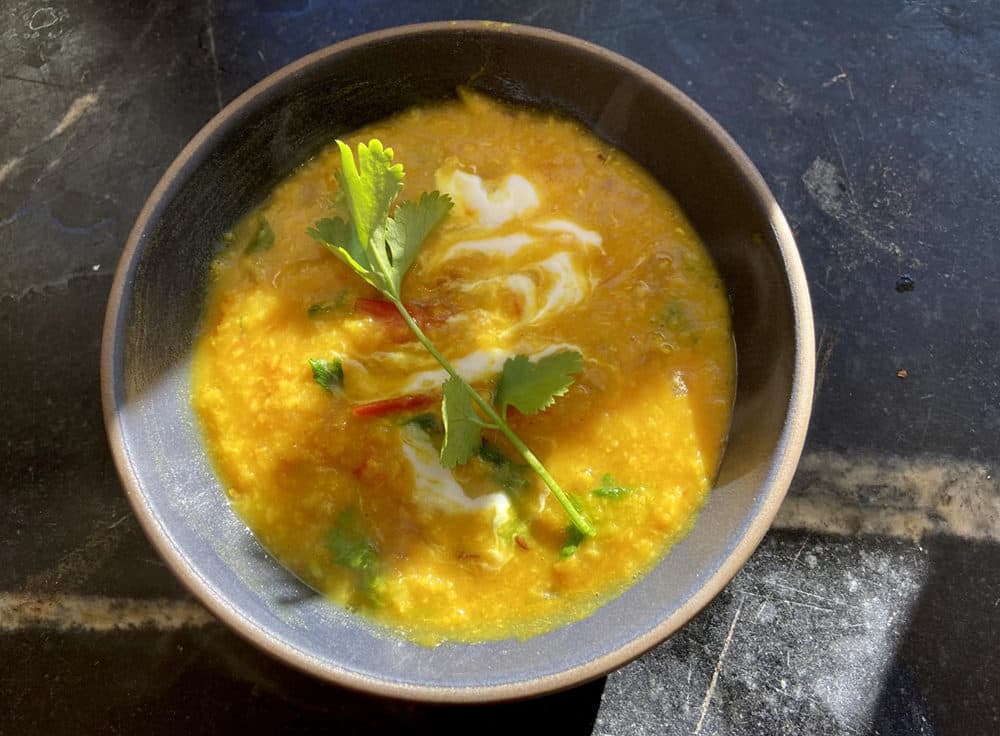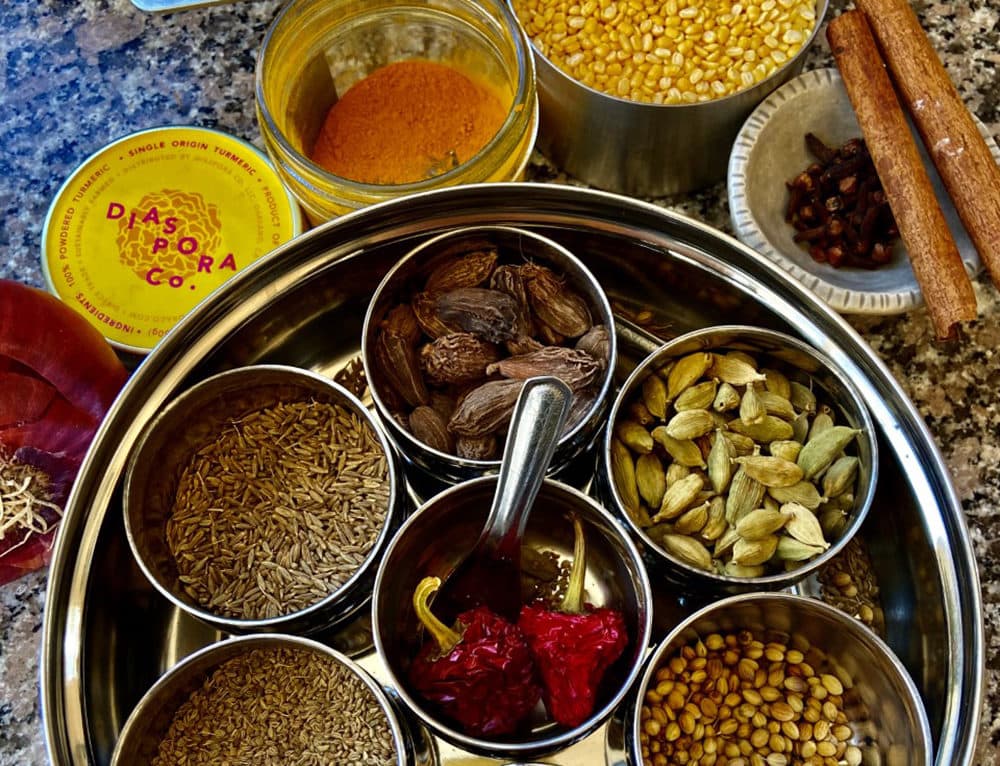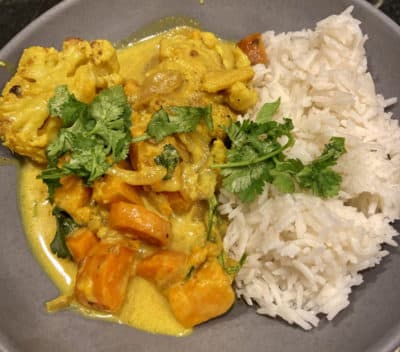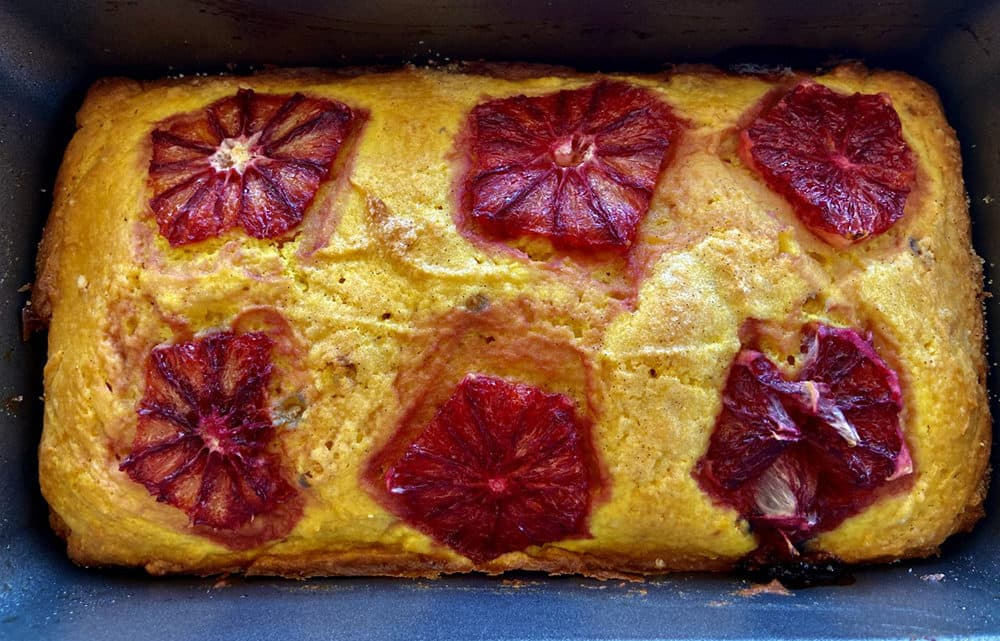Advertisement
Spice Things Up With A Touch Of Turmeric

Turmeric — with its brilliant golden-yellow color and floral, warming, slightly musky taste — is one of the primary flavors in Indian and Southeast Asian cooking. It is what gives curry powder its bright yellow color and has been used as both a spice and a medicinal herb in India for thousands of years.
Recently turmeric has become one of the darlings of the food world. Turmeric tea, turmeric milk, turmeric lattes, smoothies and turmeric-spiced foods of all kinds are featured on menus and in packaged foods.
DJ Rekha, a New York City-based DJ and cultural producer of South Asian descent, recently spoke with me about the spice.
“I find it highly infuriating to see turmeric held up as an elixir to everything,” they said. “Growing up, turmeric was at the heart of all my mom’s cooking. It was in the masala spice box right next to the salt and pepper. It was a marker of identity. A totally ordinary thing to cook with, just like salt.”
When asked if they think it’s disrespectful to use turmeric in non-traditional ways, DJ Rekha was quick to say no.
"I don’t believe in traditional food. Food is always evolving," they said. "But this new idea about turning turmeric into something mystical, exotic and magical is absurd. It feels like colonialism, as if natural food companies and high-profile chefs today are saying, ‘We discovered it and now we can profit off of it.'”
Why has turmeric hit it so big?
First, there’s the color. In the dead of winter, who can resist its marigold orange-yellow shot of brightness? Turmeric adds its sunshine bright hue to any food it’s cooked with, including boiling water. I experimented with turmeric in cakes, rice and vegetable dishes and every one of them tasted — and looked — more vibrant thanks to the addition of turmeric.
And then there are the health claims. If you believe everything you read, turmeric is the cure-all for whatever ails you.
Nik Sharma, author of "Season" and "The Flavor Equation," who grew up in the western Indian city of Mumbai and now lives in California, agrees with DJ Rekha.
Advertisement
“There are so many misconceptions about turmeric,” he says. “People think it will keep you healthy and young forever. But no one ingredient can ever do that.”
Turmeric is a dry spice that comes from the turmeric plant, a member of the ginger family. Native to India and Southeast Asia, the root is used fresh and dried. The root contains a chemical called curcumin, which is said to support health in many ways and is the pigment responsible for turmeric’s vibrant color.
Turmeric contains beta-carotene, vitamin C, potassium and zinc. Many people take turmeric supplements and oils for inflammation, joint pain, heart disease and high cholesterol. Others claim it works to alleviate depression and heartburn and improve memory.
But hardcore scientific evidence about turmeric’s benefits is difficult to find. Be aware that studies show you would have to eat or drink an awful lot of turmeric on a daily basis to see any results.
Fresh turmeric root, available in Asian markets and health food stores, can be used like fresh ginger root. Peel away the skin and chop, mince, or thinly slice and use in stir-fries, curries, soups, juices and more. Fresh turmeric root has a more peppery flavor than dried turmeric.
According to Sana Javeri Kadri, owner of Diaspora Co., you need to shop for turmeric that has not been sitting on supermarket shelves for years and lost all its color and flavor.
“Five to seven-year-old turmeric has no active curcumin left in it, but fresh turmeric, where you can get between 4 to 5.5% curcumin, is the anti-inflammatory good stuff," she says. "Consuming it in powdered form vs. fresh form is actually easier for your body to digest, and consuming it with a pinch of fresh black pepper (for its active compound piperine!) and heated with a little fat (ghee, milk, butter, you name it!) is the best way to maximize its bio-availability.”
Other Ways To Use Fresh And Dried Turmeric

- According to Nik Sharma, sprinkling uncooked turmeric powder on top of foods can “be quite harsh and pungent. It’s always best to heat it and cook with it.”
- Always use the amount of turmeric called for in a recipe and not more, or your dish will be overwhelmed by the spice.
- Generally, when using dried turmeric in Indian and South Asian dishes, it is warmed in a touch of oil with other spices (like cardamom, cumin seed, chilis, etc.) to release the flavor and toast the spices. The oil is then added to curries, soups, stews, etc.
- Add dry turmeric to rice dishes for added color and flavor.
- Rub dry turmeric on chicken skin before roasting or sautéing.
- Rub turmeric on fish filets before grilling, roasting or frying.
- Add fresh chopped or dried turmeric when you sauté or roast vegetables. Just a teaspoon or less of dried turmeric will add enormous flavor and color.
- Nik Sharma likes to cut fresh turmeric root into thin strips, sauté them in oil and steam fresh mussels on top.
- Sana Javeri Kadri of Diaspora Co. likes to add a pinch of turmeric, a crack of black pepper and a knob of butter to a pot of rice to add color and flavor.
- Add fresh chopped turmeric root and fresh ginger to a fruit smoothie.
- Add a touch of dried turmeric when cooking rice pudding.
- Make a fresh turmeric-ginger tea: Chop fresh turmeric root and ginger root and add to a pot of water. Bring to a boil and simmer for about 10 minutes. Strain and serve with lemon and honey.
- Turmeric can be used in desserts like the turmeric-blood orange cake recipe below. Nik Sharma likes to add turmeric to lemon pound cake to boost the color and give the batter a beautiful lemon color. He also makes honey and turmeric ice cream.
- And, as DJ Rekha pointed out, turmeric is a fine powder that can stain anything and everything. Take care when cooking with it not to get it on your clothes or the stain will last.
Single-Source Turmeric:
One of the very best brands of turmeric I’ve ever tasted comes from Diaspora, a woman-owned spice business. Diaspora’s turmeric is organically grown and comes from a 3rd generation turmeric farm in India. To order, click here.
Roasted Cauliflower, Carrot And Sweet Potato In Spiced Coconut Milk

Cauliflower, carrots and sweet potatoes are roasted in a hot oven to give them a slight golden color and then added to turmeric, ginger, cinnamon and spiced coconut milk.
This is a warming, deeply satisfying winter dish. Serve with basmati rice.
Serves 4.
Ingredients
- 1 medium cauliflower, about 1 pound 10 ounces
- 2 medium carrots, about 9 ounces, peeled and cut into ½-inch cubes
- 1 medium-large sweet potato about 11 ounces, peeled and cut into ½-inch cubes
- 1/4 cup vegetable oil, such as canola oil
- Sea salt and freshly ground black pepper
- 1 tablespoon chopped fresh ginger
- 1 tablespoon fresh ginger cut into thin strips
- 1 medium red onion, about 6 ounces, very thinly sliced
- 1 1/2 teaspoons ground turmeric
- 1/2 teaspoon cumin seeds, optional
- 1/2 teaspoon fennel seeds, optional
- One 2-inch cinnamon stick
- 1 teaspoon garam masala *
- Pinch red chili flakes (depending on how spicy you want the stew to be)
- 1 cup vegetable or chicken broth or water
- 1 can unsweetened coconut milk, 13.5-13.66 ounces
- About 1/3 cup chopped cilantro leaves
- Basmati rice
*Garam masala is a spice blend commonly used in curries, lentil dishes and other Indian foods. You can find it in grocery stores and Indian markets. Although every recipe differs, garam masala is generally made from a blend of cinnamon stick, mace or nutmeg, peppercorns, cloves, coriander seeds and cardamom. You can make your own by toasting 1 to 2 tablespoons of each spice (or in any combination you like) in a dry skillet for several minutes, cool and grind in a blender or spice grinder.
Instructions
- Preheat the oven to 475 degrees.
- Remove outer leaves and core from cauliflower. Separate the cauliflower into small floret pieces.
- On a sheet pan or large roasting pan, toss the cauliflower, carrots and sweet potatoes with 2 tablespoons of the oil, season with salt and pepper. Roast on the middle shelf until vegetables have a nice golden brown color, but are still not fully cooked, about 15 minutes.
- Meanwhile, in a medium to large soup pot, heat the remaining 2 tablespoons of oil over low heat. Add both the chopped and sliced ginger and onion and cook, stirring, for 10 minutes. Stir in the turmeric, cumin and fennel seeds if using, cinnamon stick, garam masala and red chili flakes and cook until fragrant, about 3 minutes. Raise the heat to medium and add the broth and coconut milk and bring to a gentle simmer, until slightly thickened, about 5 minutes. Add the roasted vegetables and any juices from the bottom of the roasting pan. Gently toss the vegetables into the spiced coconut milk, half the fresh cilantro, cover and simmer until the vegetables feel tender but are not falling apart, about 12 to 15 minutes. Taste for seasoning adding more salt, pepper or chili flakes if needed.
- Serve hot over basmati rice sprinkled with the remaining fresh cilantro.
Turmeric-Spiced Dal (Indian Lentils)
Turmeric is used in two ways in this spicy Indian-inspired lentil dish. The dal (or lentils) are simmered with dry turmeric and water and then a spicy mixture of sautéed turmeric, cumin seeds, cardamom pods, cinnamon sticks and chili pepper are sautéed in ghee (clarified butter) or vegetable oil and made into a topping with fresh ginger, red onion, tomatoes and cilantro. The spiced topping is then swirled into the cooked dal.
Serve hot, sprinkled with fresh cilantro, on top of basmati rice.
Serves 4 to 6.
Ingredients
- 1 cup dried moong dal (green split lentils) or red lentils (masoor dal)*
- 1 teaspoon salt
- 2 ¼ teaspoons ground turmeric
- 5 cups cold water
- 1 ½ tablespoons canola, vegetable oil or ghee (Indian clarified butter)
- 1 teaspoon cumin seeds*
- 1 dried red chili, crumbled with seeds or seeds removed (if you don’t want a spicy dish), or a pinch or two of dried red chili flakes
- 1 teaspoon coriander seeds*
- 1 teaspoon green cardamom pods, optional*
- 1 2-inch piece whole cinnamon stick
- 3 whole spice cloves
- 1 tablespoon minced fresh ginger
- 1 medium red onion, finely chopped
- 1 medium tomato, chopped
- ¼ cup chopped fresh cilantro with stems, plus 2 tablespoons for garnish
- Greek or plain yogurt for serving
*Look for lentils, cardamom pods and other Indian spices in Indian groceries or online. One favorite mail-order spot is Kalustyan’s in New York City.
Instructions
- In a medium pot combine the dal, salt and 1 1/4 teaspoons of the turmeric. Bring to a boil over moderately high heat, reduce the heat to low and partially cover. Cook about 30 minutes or until the water has been absorbed and the lentils are soft and cooked. Remove from the heat.
- Meanwhile, in a medium skillet, heat the oil or ghee over moderate heat. Stir in the cumin seeds, dried chili crumbles, coriander seeds, cardamom, cinnamon stick, cloves and the remaining 1 teaspoon of turmeric and cook 2 minutes, stirring. Add the ginger and onion and cook, stirring, for another 3 minutes, or until the onion is softened. Add the tomato and cook 2 minutes and then add 1/4 cup cold water. Simmer for about 4 minutes, until slightly thickened. Remove the cinnamon stick, cardamom pods and cloves.
- Heat the dal over low heat. Stir the spiced tomato/onion mixture and the ¼ cup cilantro into the dal. Taste for seasoning, adding more salt if needed. Serve hot sprinkled with the remaining 2 tablespoons cilantro and yogurt, if desired.
Turmeric-Ginger Blood Orange Cake

Turmeric adds a golden yellow hue and a hint of musk to this simple cake. The cake is baked in a loaf pan and can be made in less than 30 minutes; it will keep covered in the refrigerator for at least five days.
If you can find blood oranges — in season all winter — the cake is a gorgeous contrast of pink-red against the orange-gold of the turmeric. Serve for breakfast with yogurt or as a dessert with chai or coffee.
Ingredients
- Canola or vegetable oil spray for pan
- 1 1/2 cups flour, 215 grams
- 2 teaspoons baking powder
- 1 teaspoon salt
- 1 1/4 teaspoons dry ground turmeric
- 3/4 teaspoon ground ginger
- 1 stick unsalted butter
- 3/4 cup sugar, plus 1 tablespoon, 162 grams
- 1 1/2 teaspoons grated blood orange zest or orange zest
- 3/4 cup Greek yogurt or plain yogurt, 213 grams
- 2 medium eggs
- 2 tablespoons blood orange or orange juice
- 1 blood orange or orange, peeled and thinly sliced, seeds removed (use the orange you zested)
- Greek yogurt, for serving
Instructions
- Preheat the oven to 350 degrees.
- Spray a 9-inch loaf pan with canola oil spray or grease with oil.
- In a medium bowl, mix together the flour, baking powder, salt, 1 teaspoon of the turmeric and ground ginger.
- In a small skillet, heat the butter and the remaining 1/4 teaspoon turmeric until bubbling and just beginning to turn golden brown. Remove from the heat and cool a few minutes.
- In a large bowl, use your fingers to mix the sugar and orange zest together. Whisk in the yogurt, eggs and orange juice. Whisk in the turmeric butter. Gently fold the flour mixture into the sugar mixture until smooth.
- Place the batter into the prepared pan. Gently press the orange slices on top and place the cake on the middle shelf of the oven. Bake for 40 to 50 minutes or until a toothpick inserted in the center comes out clean. Cool on a cooling rack. Flip the cake out of the pan and flip again.
- Serve with a dollop of Greek yogurt.
Editor's note: This story has been corrected to reflect DJ Rekha's pronouns. We regret the error.
This article was originally published on January 28, 2021.
This segment aired on January 28, 2021.
